2025.01.06
- Features
-
Services/ProductsServices/ProductsServices/Products

Learn more about the retail trading conditions, platforms, and products available for trading that FXON offers as a currency broker.
You can't start without it.
Trading Platforms Trading Platforms Trading Platforms
Features and functionality comparison of MetaTrader 4/5, and correspondence table of each function by OS
Two account types to choose
Trading Account Types Trading Account Types Trading Account Types
Introducing FXON's Standard and Elite accounts.
close close

-
SupportSupportSupport

Support information for customers, including how to open an account, how to use the trading tools, and a collection of QAs from the help desk.
Recommended for beginner!
Account Opening Account Opening Account Opening
Detailed explanation of everything from how to open a real account to the deposit process.
MetaTrader4/5 User Guide MetaTrader4/5 User Guide MetaTrader4/5 User Guide
The most detailed explanation of how to install and operate MetaTrader anywhere.
FAQ FAQ FAQ
Do you have a question? All the answers are here.
Coming Soon
Glossary Glossary GlossaryGlossary of terms related to trading and investing in general, including FX, virtual currencies and CFDs.
News News News
Company and License Company and License Company and License
Sitemap Sitemap Sitemap
Contact Us Contact Us Contact Us
General, personal information and privacy inquiries.
close close

- Promotion
- Trader's Market
- Partner
-
close close
Learn more about the retail trading conditions, platforms, and products available for trading that FXON offers as a currency broker.
You can't start without it.
Features and functionality comparison of MetaTrader 4/5, and correspondence table of each function by OS
Two account types to choose
Introducing FXON's Standard and Elite accounts.
Support information for customers, including how to open an account, how to use the trading tools, and a collection of QAs from the help desk.
Recommended for beginner!
Detailed explanation of everything from how to open a real account to the deposit process.
The most detailed explanation of how to install and operate MetaTrader anywhere.
Do you have a question? All the answers are here.
Coming Soon
Glossary of terms related to trading and investing in general, including FX, virtual currencies and CFDs.
General, personal information and privacy inquiries.
Useful information for trading and market information is posted here. You can also view trader-to-trader trading performance portfolios.
Find a trading buddy!
Share trading results among traders. Share operational results and trading methods.
- Legal Documents TOP
- Client Agreement
- Risk Disclosure and Warning Notice
- Order and Execution Policy
- Complaints Procedure Policy
- AML/CFT and KYC Policy
- Privacy Policy
- eKYC Usage Policy
- Cookies Policy
- Website Access and Usage Policy
- Introducer Agreement
- Business Partner Agreement
- VPS Service Terms and Condition

This article was :
published
updated
Weekly FX Market Review and Key Points for the Week Ahead
In the foreign exchange market for the week around New Year's Day, the USDJPY fell to the lower 156 yen range on New Year's Eve. However, the pair rebounded as traders resumed buying the dollar after New Year's Day.
Meanwhile, the EURUSD and GBPUSD continued to fall as the dollar strengthened.
December 30 (Mon)
On a light trading day, the USDJPY continued to fall, dropping from the 157 yen level to the 156 yen level.
The U.S. Pending Home Sales Index for November, released on this day, exceeded expectations on a month-over-month basis (forecast: 0.8%, actual: 2.2%) but came in below expectations on a year-over-year basis (forecast: -7.9%, actual: -5.6%).
December 31 (Tue)
The USDJPY hit a low of 156.12 yen during Tokyo trading hours and then rebounded to the 157 yen level as the new year dawned in Japan.
The EURUSD fell from the 1.04 level to the 1.03 level, while the GBPUSD hovered around the 1.25.
January 1 (Wed)
The foreign exchange market was closed all over the world for New Year's Day.
January 2 (Thu)
Market liquidity began to recover to some extent from this day, prompting a shift toward dollar strength. The Dollar Index reached its highest level since September 2022, with the dollar showing firmness against major currencies.
The USDJPY briefly closed at the 158 yen level, then bounced back to the 157 yen level and stayed there for the rest of the day.
The EURUSD fell to the lower 1.02 range, and the GBPUSD also fell to the lower 1.23 range.
January 3 (Fri)
The U.S. ISM Manufacturing Index for December registered 49.3, beating the forecast of 48.4.
The USDJPY lacked direction and fluctuated within a limited range throughout the day. The EURUSD and GBPUSD both made gradual recoveries from the lows they reached on January 2nd.
Economic Indicators and Statements to Watch this Week
(All times are in GMT)
January 7 (Tue)
- 10:00 Europe: December Harmonised Index of Consumer Prices (preliminary HICP index)
- 10:00 Europe: December Harmonised Index of Consumer Prices (preliminary HICP core index)
- 15:00 U.S.: December ISM Non-Manufacturing PMI (composite)
January 8 (Wed)
- 13:15 U.S.: December ADP National Employment Report
- 19:00 U.S.: Minutes of the Federal Open Market Committee (FOMC)
January 10 (Fri)
- 13:30 U.S.: December change in nonfarm payrolls
- 13:30 U.S.: December unemployment rate
- 13:30 U.S.: December average hourly earnings
This Week's Forecast
The following currency pair charts are analyzed using an overlay of the ±1 and ±2 standard deviation Bollinger Bands, with a period of 20 days.
USDJPY
The USDJPY has many factors that help strengthen the dollar. The Bank of Japan has not indicated that it will raise interest rates at its January meeting, while speculation that the Federal Reserve Board will make another rate cut has receded.
There is also the possibility that President-elect Donald Trump will introduce a new tariff policy soon after his inauguration. This week, traders will be focusing on the U.S. job figures to be released on January 10th.
Next is an analysis of the USDJPY daily chart.
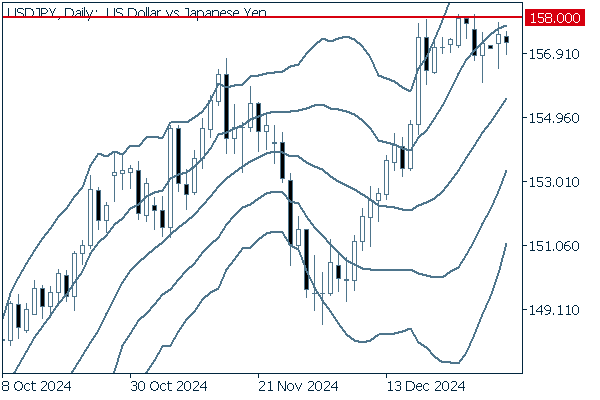

On the daily chart, the pair has been fluctuating within a box-shaped range as it repeatedly hit the ceiling of around 158 yen. However, the ascending middle line indicates that a continuation of the uptrend is more likely even after the pair clearly breaks above the 158 yen level.
We continue with an analysis of the USDJPY weekly chart.
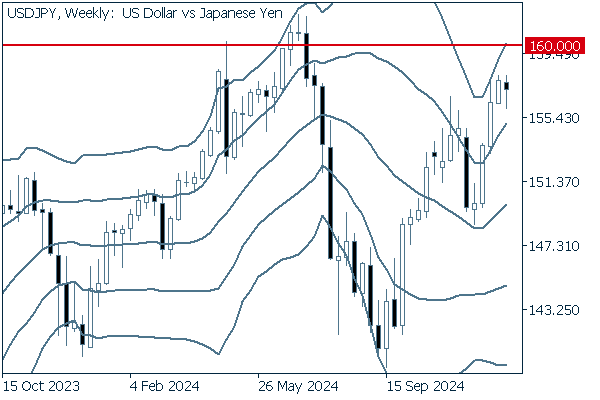

Although a bearish candlestick appeared last week, the pair has been fluctuating between +1σ and +2σ. The clearly ascending middle line indicates that the uptrend is likely to continue, as the next target is 160 yen.
EURUSD
The EURUSD is clouded by uncertainty over the European economy and politics in Germany and France, as well as concerns over Donald Trump's tariff policy. In addition, there is speculation that the European Central Bank will make further interest rate cuts. These factors are reinforcing the selling of the euro.
Next is an analysis of the EURUSD daily chart.
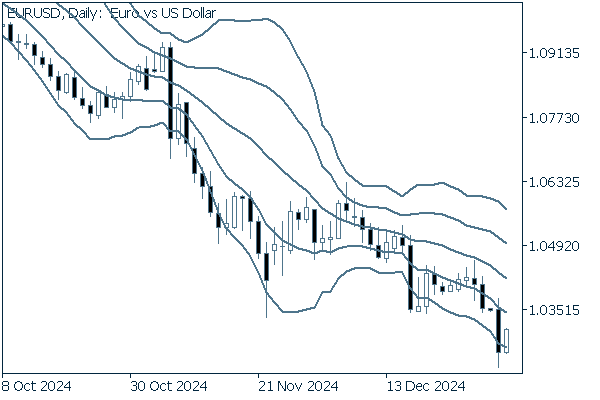

The pair once tried to recover from its mid-December plunge. However, it has been falling since failing to break above the middle line. It is safe to say that this downtrend is likely to continue for the time being.
We continue with an analysis of the EURUSD weekly chart.


On the weekly chart, the pair once had fluctuated within a box-shaped range since 2022. However, it has now broken below the range, as the band walk shows a downward trend. The pair is about to break below 1.02 and may fall as low as 1.01.
GBPUSD
Lingering uncertainty about the British economy is fueling speculation of another interest rate cut. With no major U.K. economic releases this week, the dollar's behavior will likely affect the GBPUSD.
Now, we analyze the daily GBPUSD chart.
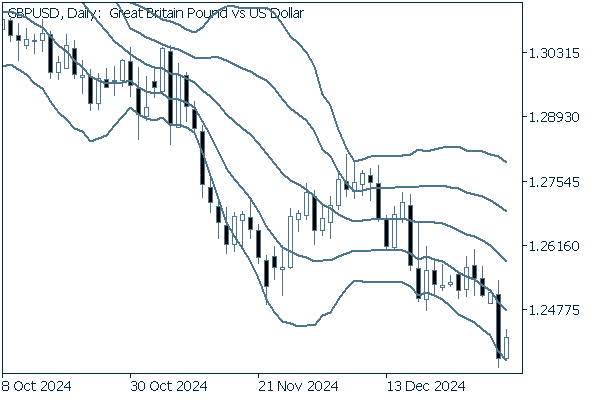

Although the pair traded above -1σ earlier last week, it renewed its low on January 2nd. As the angle of the descending middle line becomes steeper, it seems that the downtrend will continue.
We continue with an analysis of the GBPUSD weekly chart.
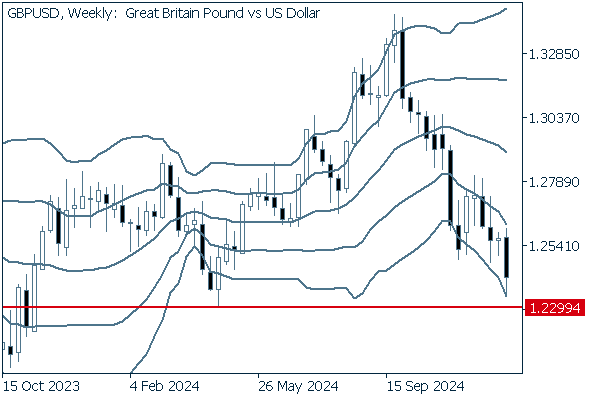

The pair is falling as it has not touched the middle line since the second week of November 2024. A break below 1.229, the low set in April 2024, will strengthen the downtrend.
Was this article helpful?
0 out of 0 people found this article helpful.
Thank you for your feedback.
FXON uses cookies to enhance the functionality of the website and your experience on it. This website may also use cookies from third parties (advertisers, log analyzers, etc.) for the purpose of tracking your activities. Cookie Policy
